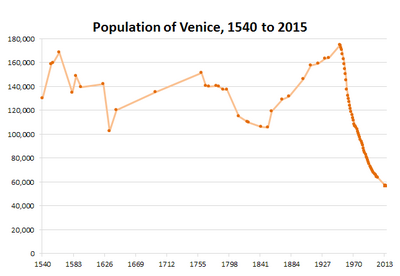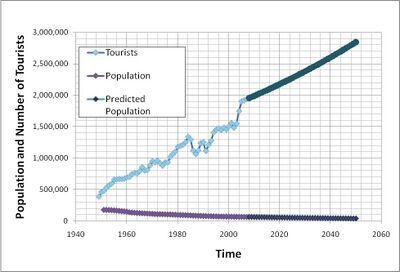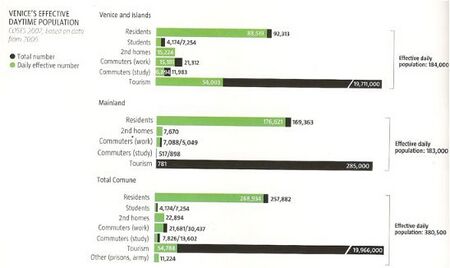Demographics: Difference between revisions
No edit summary |
No edit summary |
||
| (3 intermediate revisions by one other user not shown) | |||
| Line 1: | Line 1: | ||
[[File:Scan0027.jpg|right|thumb|500px|Household Sizes]]In 2009, the number of registered residents in Venice was 60,208, with a additional 30,362 living in | [[File:Scan0027.jpg|right|thumb|500px|Household Sizes]]In 2009, the number of registered residents in Venice was 60,208, with a additional 30,362 living in islands and estuary of Venice. These 90,570 people are designated as permanent residents of the "lagoon city," a term referring to the people of the mainland of Venice, the Lido, Pellestrina, and the outlaying islands. | ||
Currently, the total population of Venice was recently recorded at 270, | Currently, the total population of Venice was recently recorded at [http://en.comuni-italiani.it/027/042/ 270,884 people] (which includes mainland Venice as well as the surrounding islands and lagoon). Of these, 47.4% were male and 52.6% were female. Minors (those 18 years or younger) made up 14.36% of the population, whereas pensioners made up 25.7%. The overall Italian population is, by contrast, made up of 18.06% minors (more than Venice) and 19.94% pensioners. The average age of a Venetian resident is 46, four years older than the Italian average of 42. | ||
==Permanent Residents== | ==Permanent Residents== | ||
The official resident population of Venice is distributed in a ratio of approximately 22:8:70 between the historic city, the islands, and the mainland (only the official residents are allowed to vote). This demographic disparity means that in electoral terms, the historic city is now | The official resident population of Venice is distributed in a ratio of approximately 22:8:70 between the historic city, the islands, and the mainland (only the official residents are allowed to vote). This demographic disparity means that in electoral terms, the historic city is now a minority. When local politicians refer to "Venezia," they are no longer referring to the Venice the world thinks of but to the Venice which includes the regional Veneto. | ||
The total population of the municipality reached its peak in 1968 at 367,832. Although the population of the historic city of Venice was declining by then, industrialization at Marghera on the edge of the lagoon was flourishing. Population in the lagoon on the islands and the estuary areas also continued growing until the late 1960's, particularly as a result of thriving glass production on the island of Murano. | The total population of the municipality reached its peak in 1968 at 367,832. Although the population of the historic city of Venice was declining by then, industrialization at Marghera on the edge of the lagoon was flourishing. Population in the lagoon on the islands and the estuary areas also continued growing until the late 1960's, particularly as a result of thriving glass production on the island of [[Murano]]. | ||
More recently, the population of the lagoon (the historic city, the Lido, Pellestrina and the islands) has fallen by more than a third (since 1981), double the rate of the decrease on the mainland areas of Venice. | More recently, the population of the lagoon (the historic city, the Lido, Pellestrina and the islands) has fallen by more than a third (since 1981), double the rate of the decrease on the mainland areas of Venice. | ||
| Line 16: | Line 16: | ||
===Population Trends=== | ===Population Trends=== | ||
[[File:Population 1540 to 2015.png|left|thumb|400px|The population of Venice, 1540 to 2015]] | |||
[[File:Population Prediction.jpg|Right|thumb|400px|Estimated population increases [http://comicka.com/content/html5map.html See: Interactive Map]]] | [[File:Population Prediction.jpg|Right|thumb|400px|Estimated population increases [http://comicka.com/content/html5map.html See: Interactive Map]]] | ||
The resident population all over Venice has also been decreasing. In the five years between 2002 and 2007, the population of Venice declined overall by 0.2%, while Italy as a whole grew by 3.85%.<ref>[http://demo.istat.it/bil2007/index.html "Statistiche demografiche ISTAT"] . Demo.istat.it. Retrieved 28 March 2009</ref> But the population in the historic city alone is declining at a significantly faster rate: from about 120,000 in 1980 to about 60,000 in 2009.<ref>Cathy Newman, "Vanishing Venice" | The resident population all over Venice has also been decreasing. In the five years between 2002 and 2007, the population of Venice declined overall by 0.2%, while Italy as a whole grew by 3.85%.<ref>[http://demo.istat.it/bil2007/index.html "Statistiche demografiche ISTAT"] . Demo.istat.it. Retrieved 28 March 2009</ref> But the population in the historic city alone is declining at a significantly faster rate: from about 120,000 in 1980 to about 60,000 in 2009.<ref>Cathy Newman, "Vanishing Venice," National Geographic, August 2009</ref> | ||
Taken alone, the municipality's official figures would appear to confirm the widely held belief that Venice is shrinking: since 1952 when the number of residents in the "lagoon city" peaked at 218,991, the permanent registered population has diminished by more than 60% and steadily continues its decline. It has shrunk by a further 9% since the beginning of the century or an average of 1,000 people annually. <ref>Commune di Venezia, Statistical Office, Venice 2006</ref> | Taken alone, the municipality's official figures would appear to confirm the widely held belief that Venice is shrinking: since 1952 when the number of residents in the "lagoon city" peaked at 218,991, the permanent registered population has diminished by more than 60% and steadily continues its decline. It has shrunk by a further 9% since the beginning of the century or an average of 1,000 people annually. <ref>Commune di Venezia, Statistical Office, Venice 2006</ref> | ||
| Line 33: | Line 36: | ||
Venice is one of the worlds most visited cities due to its' long legacy of beautiful and historically important art. In 2007, it was estimated that 50,000 visitors visited Venice each day, and showed no signs of weakening as the years pass. In 2007 it was projected that there would be at least twenty million visitors that will occupy Venice alone in the next year<ref> | Venice is one of the worlds most visited cities due to its' long legacy of beautiful and historically important art. In 2007, it was estimated that 50,000 visitors visited Venice each day, and showed no signs of weakening as the years pass. In 2007 it was projected that there would be at least twenty million visitors that will occupy Venice alone in the next year<ref> | ||
"[http://www.travelindustrydeals.com/news/5109 Italy's Venice on track for record tourism year: official]", Nov 20, 2007</ref>. However, this large amount of tourism traffic has caused many issues in Venice. [[ | "[http://www.travelindustrydeals.com/news/5109 Italy's Venice on track for record tourism year: official]", Nov 20, 2007</ref>. However, this large amount of tourism traffic has caused many issues in Venice. For more information, see [[Tourism]]. | ||
==Ethnicity== | ==Ethnicity== | ||
| Line 48: | Line 51: | ||
==External Links== | ==External Links== | ||
*[http://en.comuni-italiani.it/027/042/ Demographic information on City of Venice] | *[http://en.comuni-italiani.it/027/042/ Demographic information on City of Venice] | ||
[[Category:Demographics]] | |||
Latest revision as of 04:37, 27 January 2015

In 2009, the number of registered residents in Venice was 60,208, with a additional 30,362 living in islands and estuary of Venice. These 90,570 people are designated as permanent residents of the "lagoon city," a term referring to the people of the mainland of Venice, the Lido, Pellestrina, and the outlaying islands.
Currently, the total population of Venice was recently recorded at 270,884 people (which includes mainland Venice as well as the surrounding islands and lagoon). Of these, 47.4% were male and 52.6% were female. Minors (those 18 years or younger) made up 14.36% of the population, whereas pensioners made up 25.7%. The overall Italian population is, by contrast, made up of 18.06% minors (more than Venice) and 19.94% pensioners. The average age of a Venetian resident is 46, four years older than the Italian average of 42.
Permanent Residents
The official resident population of Venice is distributed in a ratio of approximately 22:8:70 between the historic city, the islands, and the mainland (only the official residents are allowed to vote). This demographic disparity means that in electoral terms, the historic city is now a minority. When local politicians refer to "Venezia," they are no longer referring to the Venice the world thinks of but to the Venice which includes the regional Veneto.
The total population of the municipality reached its peak in 1968 at 367,832. Although the population of the historic city of Venice was declining by then, industrialization at Marghera on the edge of the lagoon was flourishing. Population in the lagoon on the islands and the estuary areas also continued growing until the late 1960's, particularly as a result of thriving glass production on the island of Murano.
More recently, the population of the lagoon (the historic city, the Lido, Pellestrina and the islands) has fallen by more than a third (since 1981), double the rate of the decrease on the mainland areas of Venice.
Age of Population
The average age of people living in the historic city of Venice went up from 40.6 years old (in 1981) to 48.2 (in 2001). Before 1991, more than 60% of the population fell within the 14-59 age bracket, but by 2001 the range had fallen to 58% and the proportion of people age 60 and up stood at almost 35%, significantly higher than 30 years earlier.
Consequently, the historic city has a disproportionate share of older residents. In 1971, 23.8% of this historic city's population was aged over 60 (compared to 16.9% in the Commune as a whole.) By 2001, the share of over-60s in the historic city had risen to 349% (against 31.3% in the Commune.) The Commune predicts that by 2015, the proportion of over-60s overall in the "lagoon city" will have risen to 37%.
Population Trends


The resident population all over Venice has also been decreasing. In the five years between 2002 and 2007, the population of Venice declined overall by 0.2%, while Italy as a whole grew by 3.85%.[1] But the population in the historic city alone is declining at a significantly faster rate: from about 120,000 in 1980 to about 60,000 in 2009.[2] Taken alone, the municipality's official figures would appear to confirm the widely held belief that Venice is shrinking: since 1952 when the number of residents in the "lagoon city" peaked at 218,991, the permanent registered population has diminished by more than 60% and steadily continues its decline. It has shrunk by a further 9% since the beginning of the century or an average of 1,000 people annually. [3]
The official resident population of the historic city of Venice shows an even more marked fall, from a peak of 174,808 in 1951 to 60,208 in 2008. But the real population of Venice includes many others who "inhabit" the city, albeit less officially. Excluding the numerous tourists and day-trippers who collectively make heavy demands on the city's infrastructure, other residents include people with secondary homes, commuting workers, students, and the steady flow of people who come to Venice to use its public administration offices.
In 1994, the Venice Commune first attempted to estimate and evaluate the population from a new perspective; another study was published in 2006 (using data from 2004) and most recently, a 2007 study, updated in 2008 by COSES (the Consortium for Research and Educational Training, a research study center established by the City and Province of Venice) concluded that the number of people present in Venice on an average day is 143,450 including the tourists.[4] This is over 50% more than the total resident population of the "lagoon city" and over 100% more than the number of residents in the historic cit, where the bulk of this transit population goes.

This concept of "popolazione presente", or the effective population, has grown in importance and become a common method for studying issues concerning large metropolises and urban sociology. The increased mobility of people means that the actual human load on a city is much larger (and of a different nature) than that created solely by residents and it needs to be measured and described.
To understand what this level of human presence means to Venice, it is more meaningful to convert the annual number for effective population (used for economic statistics) to an equivalent population figure, which gives a better idea of the number of people in Venice on a typical day of the year (but does not take account of seasonal variations), for planning purposes such as the calibration of city services. This transformed estimate of the real population of Venice considers the inhabitants of Venice in a wider sense and encompasses as many as possible of the city's stakeholders.
The shrinking number of permanent residents. though a serious issue, pales in comparison to the global importance of the city, its heritage and the number of transient "city users" and leisure visitors.
Tourism Population
Venice is one of the worlds most visited cities due to its' long legacy of beautiful and historically important art. In 2007, it was estimated that 50,000 visitors visited Venice each day, and showed no signs of weakening as the years pass. In 2007 it was projected that there would be at least twenty million visitors that will occupy Venice alone in the next year[5]. However, this large amount of tourism traffic has caused many issues in Venice. For more information, see Tourism.
Ethnicity
As of 2009, 91,14% of the population was Italian. The largest immigrant group comes from other European nations (Romanians, the largest group: 3.26%, South Asia: 1.26%, and East Asia: 0.9%).
Religion
Venice is predominantly Roman Catholic, but because of the long standing relationship with Constantinople there is also a perceptible Orthodox presence, and due to immigration it now has some Muslim, Hindu and Buddhist inhabitants. There is also a historic Jewish Community in Venice. The Venetian Ghetto was the area of in which Jews were compelled to live under the Venetian Republic. The word "ghetto", used in many languages, is derived from this instance. Notably, William Shakespeare's play The Merchant Of Venice, written ca. 1595, features Shylock, a Venetian Jew and his family. Venice also has an eruv,[6] built for and still used by the Jewish community.
References
- ↑ "Statistiche demografiche ISTAT" . Demo.istat.it. Retrieved 28 March 2009
- ↑ Cathy Newman, "Vanishing Venice," National Geographic, August 2009
- ↑ Commune di Venezia, Statistical Office, Venice 2006
- ↑ Di Monte G. and G. Santoro, Venice metropolitan area, Doc COSES 1032.0, October 2008
- ↑ "Italy's Venice on track for record tourism year: official", Nov 20, 2007
- ↑ "Venetian Ghetto - Eruv in Venice" . Retrieved 2010-08-02.